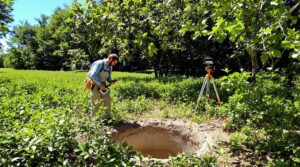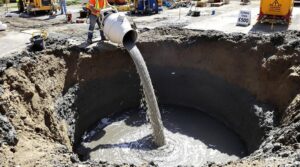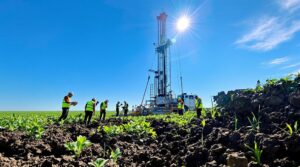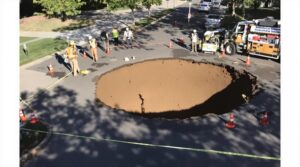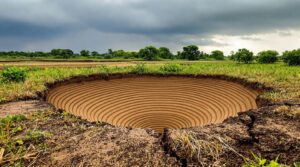Sinkhole inspection costs begin at $70 for basic visual assessments through insurance vendors, while extensive geological evaluations can exceed $138,920. Initial warning signs include ground depressions, structural cracks, and cloudy well water. Insurance coverage varies by state, with Florida and Tennessee mandating sinkhole protection options. Public adjusters typically secure higher settlements, charging 10-20% of claim values. Professional inspection methods utilize ground-penetrating radar and remote sensing technologies to detect subsurface anomalies. Understanding the full scope of assessment options guarantees ideal protection.
Key Takeaways
- Initial visual inspections are baseline costs, while advanced geological testing with ground-penetrating radar significantly increases expenses.
- Engineering studies for thorough sinkhole evaluations can exceed $138,920, with basic repair costs ranging from $10,000 to $100,000.
- Insurance coverage varies by state, with Florida and Tennessee requiring sinkhole coverage while others offer optional endorsements.
- Public adjusters typically charge 10-20% of settlement amounts but often secure higher payouts than independently filed claims.
- Insurance companies may cover testing costs up to $2,500 if sinkhole activity is confirmed during professional assessment.
Understanding Sinkhole Inspection Basics
Effective sinkhole inspection requires understanding both the warning signs and assessment protocols that indicate potential ground instability.
Initial visual surveys focus on identifying key indicators such as ground depressions, structural cracks, and tilting elements like utility poles or fences. The presence of cloudy well water or sudden pond formation can also signal underlying sinkhole development.
Professional assessments employ various inspection technologies to evaluate sinkhole types and their progression. These include systematic probing of excavations in carbonate-rich areas and the deployment of sophisticated monitoring systems like inclinometers and survey markers. Scientists utilize seismographic testing tools to identify hidden underground cavities that may develop into sinkholes.
Inspectors examine soil conditions, particularly noting unusual moisture levels or soft spots that could indicate subsurface void formation. The findings are documented in detailed reports that outline observed conditions and potential risks.
This systematic approach enables early detection of ground movement and helps determine appropriate intervention strategies before significant structural damage occurs.
The Real Costs of Sinkhole Damage Assessment
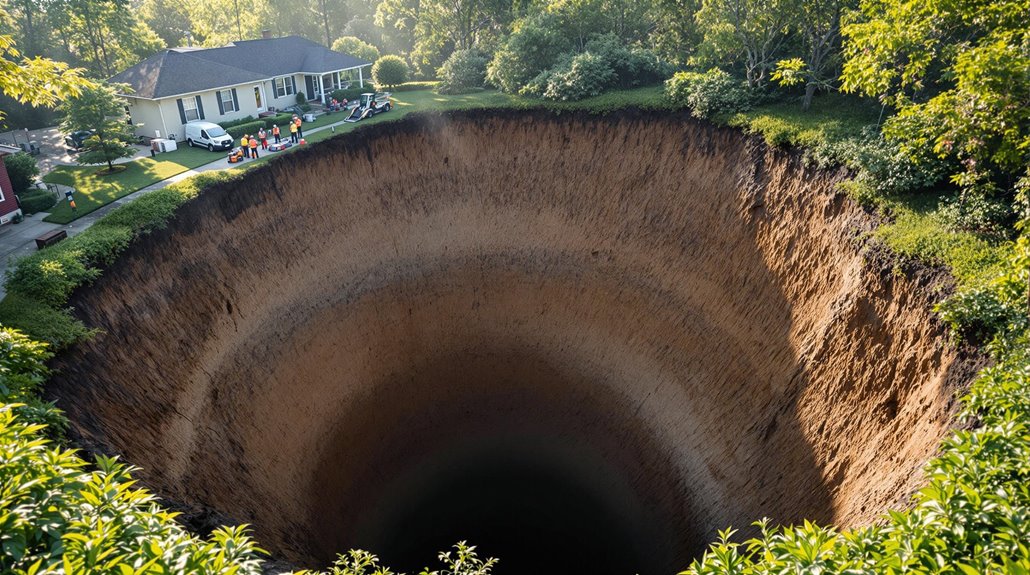
Determining the true costs of sinkhole damage assessment involves analyzing multiple financial components that vary greatly based on the scope and complexity of the investigation.
Initial visual inspections represent the baseline expense, while advanced geological testing, including ground-penetrating radar and soil borings, considerably increases assessment costs.
Professional engineering studies can range from modest amounts for small sinkholes to substantial figures exceeding $138,920 for thorough evaluations, as demonstrated in the SMC MUD project.
Structural engineers evaluate damage extent while examining the property's foundation for signs of instability and potential collapse risks.
The depth and size of sinkholes directly impact expenses, with repair costs spanning from $10,000 for minor cases to over $100,000 for extensive damage.
Emergency interventions often command premium rates, exemplified by the $45,242 Oak Ridge North expenditure.
Property layout and investigation methods influence the final assessment costs, while the implementation of advanced techniques like hydrogeological analyses and compaction grouting plans further affects the total investment required for proper sinkhole damage evaluation and remediation.
Insurance Coverage and Payment Terms

Sinkhole insurance coverage operates distinctly from standard homeowners policies, with specific regulations varying by state and region.
While most standard policies exclude sinkhole damage, states like Florida and Tennessee mandate insurers to offer this protection, whereas Alabama, Kentucky, Pennsylvania, and Texas allow optional endorsements.
The payment structure for sinkhole coverage includes deductible options typically calculated as a percentage of the dwelling limit, ranging from 1% to 10% in Florida. Most insurers require aggregate deductibles funded in segregated accounts for comprehensive coverage.
Insurers must disburse repair funds as work progresses, without requiring advance payments from policyholders.
When claims are filed, insurers must submit professional engineering reports to county property appraisers.
Coverage limits may restrict payments to actual cash value until property owners initiate stabilization repairs.
If repair costs exceed policy limits, insurers must either complete recommended repairs or tender policy limits.
Annual premiums require full payment or approved installment plans, with specific restrictions on premium financing arrangements.
Essential Steps in the Inspection Process
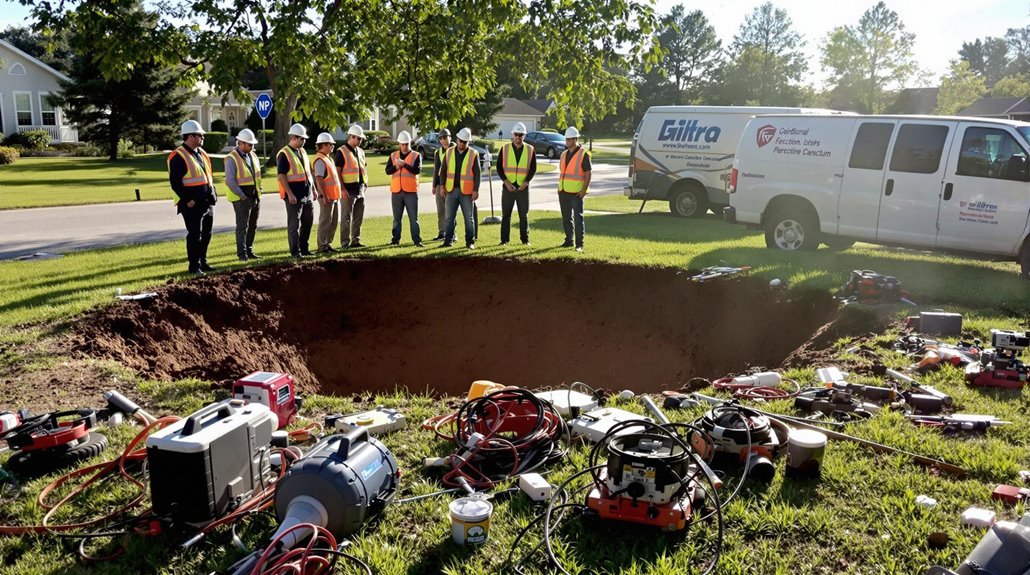
The evaluation of a potential sinkhole site requires a systematic approach that begins with ordering professional inspections from qualified geologists and engineers.
Cost allocation for these inspections often involves negotiations between property owners and insurance carriers to determine payment responsibilities and potential sharing arrangements.
Analysis of the resulting technical reports provides critical data for determining remediation requirements and insurance coverage decisions.
Ordering Professional Site Evaluations
Professional site evaluations begin with a systematic approach to documenting and evaluating potential sinkhole damage through multiple distinct phases.
The site evaluation process requires engaging multiple specialists, including geotechnical engineers and geologists, who utilize advanced investigation techniques to assess subsurface conditions and structural impacts.
Key components of expert engagement include:
- Extensive photo documentation and data collection of visible damage patterns
- Implementation of specialized tools such as ground penetrating radar and electrical resistivity testing
- Coordination of joint inspections with potentially responsible parties to maintain procedural integrity
The evaluation methodology incorporates GIS-based approaches, soil borings, and cone penetration tests to determine sinkhole susceptibility and extent.
This technical assessment provides essential documentation for insurance claims while establishing a foundation for remediation planning.
Payment and Cost Sharing
Understanding payment obligations and cost-sharing procedures represents a critical component of sinkhole inspection processes. Inspection fees typically begin with a pre-arranged cost of $70 through insurance vendors, while independent inspections require full payment by policyholders. Reimbursement policies vary based on inspection outcomes and testing requirements.
| Cost Type | Payment Responsibility | Reimbursement Status |
|---|---|---|
| Pre-inspection | Policyholder | Non-refundable |
| Testing Costs | 50% up to $2,500 | Reimbursable if confirmed |
| Independent Inspection | Policyholder | Non-reimbursable |
When sinkhole activity is confirmed, insurers may cover testing costs up to $2,500. Additional payments are disbursed as repairs progress, with initial payments covering actual cash value of damages, excluding underpinning and grouting costs. Policyholders must meet deductible requirements before coverage applies.
Report Analysis and Decisions
Following thorough sinkhole inspections, report analysis requires systematic evaluation of multiple data points to inform critical decisions about property management and remediation efforts.
Professional geologists and geotechnical engineers analyze inspection findings to determine the presence, extent, and severity of subsidence damage.
Key elements of report interpretation include:
- Assessment of ground-penetrating radar (GPR) data and soil boring results
- Evaluation of geological test outcomes, including resistivity surveys
- Analysis of surface indicators and structural impact measurements
The extensive review of these technical reports guides decision-making regarding property purchases, insurance coverage, and necessary mitigation strategies.
Engineers utilize this data to recommend appropriate foundation systems and improvement methods, while considering the varying risks associated with different remediation approaches.
This analytical process guarantees informed decisions based on scientific evidence and professional expertise.
Early Warning Signs and Detection Methods
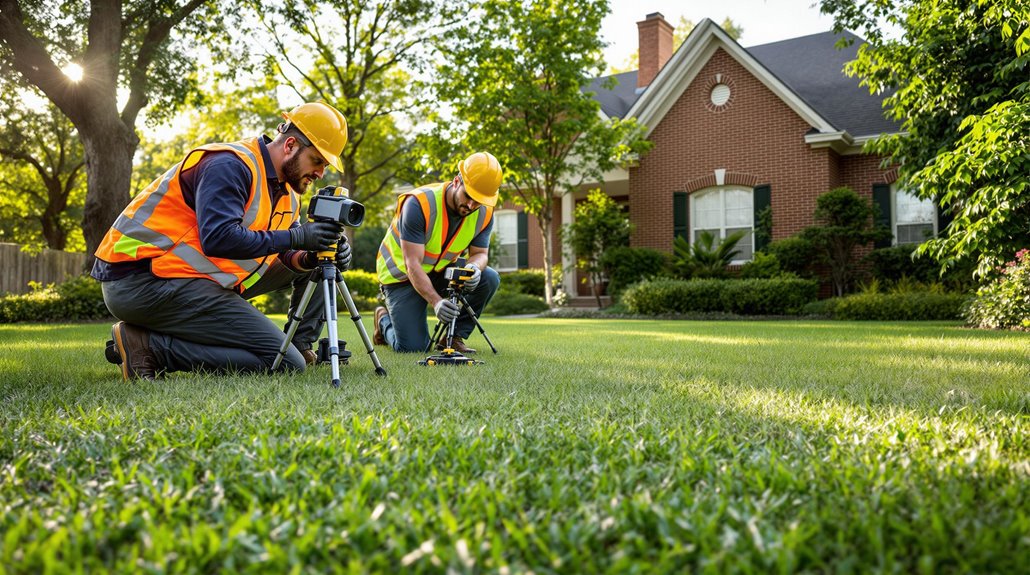
Detecting potential sinkhole formation requires vigilant observation of both visible surface indicators and subsurface anomalies through specialized detection methods. Common sinkhole symptoms include rapid depressions in yards, foundational cracking, general settlement issues, patches of dead vegetation, and tilting structures like trees or fence posts.
Advanced detection techniques employ multiple technological approaches to identify subsurface voids. Ground Penetrating Radar (GPR) transmits energy pulses into the ground, utilizing various antenna frequencies for different depth penetrations.
Remote sensing methods, including field spectrometry and frequency domain electromagnetic instruments, provide detailed subsurface imaging. These detection techniques analyze soil electrical conductivity and moisture levels, which typically show higher readings near developing sinkholes.
Professional geotechnical teams conduct thorough inspections using these methods, comparing spectral signatures between affected and unaffected areas while monitoring embryonic sinkholes.
This systematic approach enables early identification of potential hazards, allowing for preventive measures before significant damage occurs.
Navigating Policy Requirements and Resources
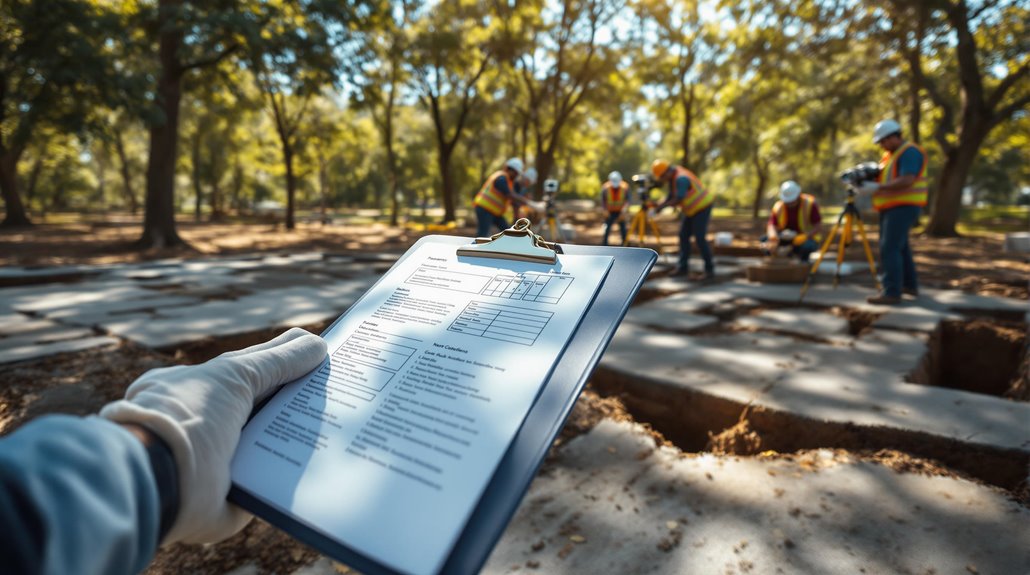
Once potential sinkhole activity has been identified, property owners must navigate complex insurance requirements and policy provisions. Understanding coverage options and policy exclusions becomes vital, particularly in states like Florida and Tennessee where specific regulations govern sinkhole insurance offerings.
Property owners should consider these fundamental aspects when reviewing their insurance needs:
- Documentation of structural damage through extensive photos and videos
- Geological assessment reports indicating property vulnerability
- Professional engineering evaluations confirming sinkhole presence
The claims process typically involves multiple stages, from initial field adjuster inspections to detailed geological assessments. In Florida, property owners must enter into repair contracts within 90 days of receiving their assessment report.
Coverage may include ground stabilization, structural repairs, and temporary relocation expenses if the home becomes uninhabitable. However, most policies exclude pre-existing conditions and soil damage, making thorough pre-purchase property evaluation vital for potential homebuyers in sinkhole-prone regions.
The Benefits Of Consulting A Public Adjuster
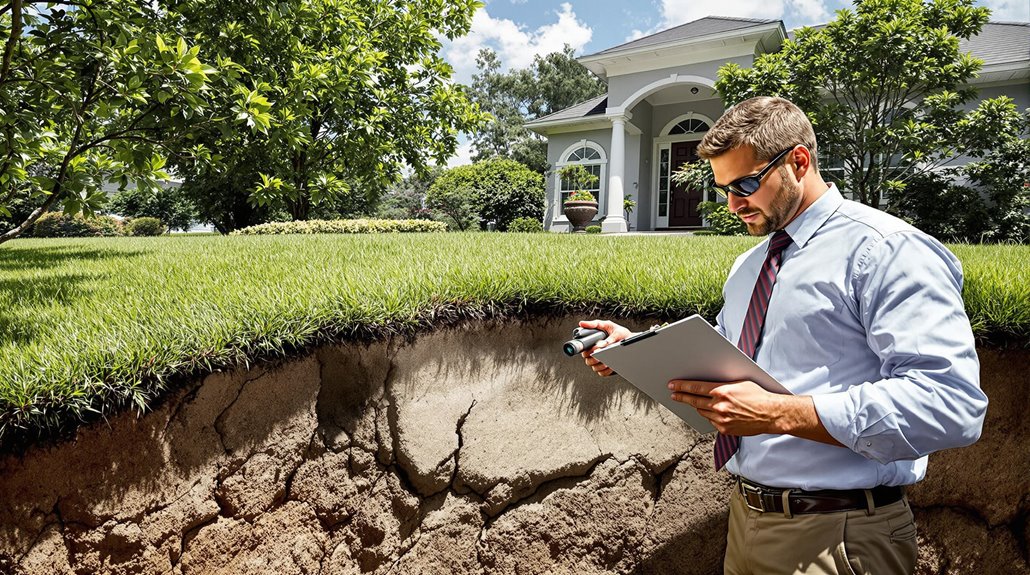
Public adjusters bring specialized expertise in maneuvering complex sinkhole insurance claims while providing objective damage assessments that guarantee all property impacts are properly documented.
Their professional involvement streamlines the claims process by efficiently managing documentation requirements, policy provisions, and insurance company communications.
Statistics indicate that claims handled by public adjusters typically result in markedly higher settlements compared to those filed independently by property owners.
While fees typically range between 10 to 20 percent of the final settlement amount, the significantly increased payouts often justify this investment.
Expertise In Insurance Claims
Professional expertise in insurance claims handling represents a critical advantage when dealing with sinkhole-related damages. Public adjusters possess extensive knowledge in insurance policy interpretation and utilize proven claim negotiation strategies to maximize settlements. Their specialized understanding of policy provisions and regulatory requirements guarantees thorough coverage assessment.
Key aspects of professional claims expertise include:
- Thorough analysis of policy language to identify all applicable coverage benefits
- Strategic documentation of structural damage and property losses
- Expert negotiation with insurance carriers using evidence-based methods
These licensed professionals leverage their background in insurance operations to navigate complex claim procedures efficiently.
Their experience in counter-offering low settlements and presenting compelling evidence supports policyholders in securing fair compensation for sinkhole damages, while guaranteeing compliance with state regulations and documentation requirements.
Unlike insurance adjusters who serve company interests, public adjuster fees are based on a percentage of the final settlement amount, ensuring their commitment to maximizing client payouts.
Objective Damage Assessment
Thorough damage assessment represents a critical first step in successfully maneuvering sinkhole insurance claims. Public adjusters utilize specialized inspection techniques to evaluate property damage thoroughly, identifying both visible and concealed structural issues that may not be immediately apparent.
Professional damage documentation involves meticulous recording of all impairments, supporting evidence collection, and detailed analysis of causation factors. This systematic approach guarantees that insurance claims accurately reflect the full scope of property damage.
Public adjusters' objective evaluations help establish clear connections between sinkhole activity and resulting structural problems. Their expertise in policy interpretation and claims procedures enables effective navigation of complex insurance requirements.
This objective assessment process typically results in more thorough settlements, as adjusters identify and document damages that might otherwise go unnoticed or uncompensated. Operating on a contingency fee basis, public adjusters are motivated to secure the highest possible settlement while reducing stress for property owners.
Streamlined Claim Process
While maneuvering complex sinkhole insurance claims can be overwhelming for property owners, consulting a public adjuster streamlines the process through expert guidance and systematic documentation.
These licensed professionals conduct thorough policy evaluation to identify coverage parameters and potential exclusions, ensuring maximum benefit utilization.
Public adjusters facilitate efficient claim negotiation through:
- Extensive damage assessment and detailed documentation compilation
- Strategic communication with insurance carriers and technical experts
- Implementation of proven methodologies for expedited claim resolution
Their expertise proves particularly valuable when addressing complex sinkhole claims, as they navigate intricate policy provisions and technical requirements.
Public adjusters maintain transparency throughout the process while alleviating the burden on property owners, ultimately working to secure fair settlements through professional representation and industry knowledge.
Members of Public Claims Adjusters Network must demonstrate at least three years of experience and maintain high ethical standards to ensure quality representation for policyholders.
Higher Claim Payouts & Settlements
Engaging a public adjuster for sinkhole damage claims consistently leads to higher settlement amounts through thorough technical assessment and expert negotiation strategies. Their specialized knowledge enables extensive documentation of both visible and concealed damage, supported by engineering and geological evidence.
Public adjusters employ proven claim negotiation strategies, leveraging their policy expertise to identify all available coverage options while avoiding exclusions. Their objective assessment and professional representation guarantee that insurance companies recognize the true extent of sinkhole damage.
Studies demonstrate that policyholders represented by public adjusters achieve notably higher compensation.
When maximizing settlements, public adjusters focus on securing funds for complete restoration, including foundation stabilization and rebuilding costs. Their understanding of complex policy terms and ability to counter insurance company arguments strengthens the policyholder's position throughout the claims process.
With commission rates ranging from 5% to 15% of final settlements, public adjusters provide value through their proven ability to secure substantially higher payouts for property owners.
About The Public Claims Adjusters Network (PCAN)
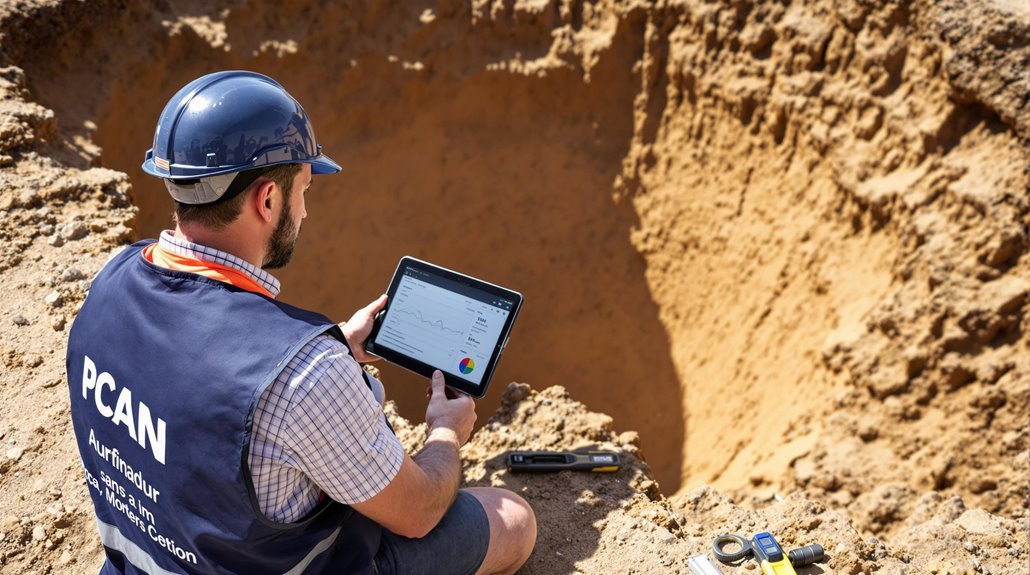
Professional expertise forms the foundation of the Public Claims Adjusters Network (PCAN), a global organization of licensed claims professionals who advocate exclusively for policyholders.
PCAN members demonstrate thorough claims adjuster qualifications, including extensive knowledge of construction costs, property valuation, and complex policy interpretation.
Public adjuster services through PCAN encompass:
- Thorough documentation and assessment of property damage
- Strategic negotiation with insurance carriers for maximum settlements
- Complete management of the claims process from initial filing to resolution
Operating across five continents, PCAN professionals specialize in both residential and commercial claims, delivering customized solutions for each unique situation.
Their fee structure typically involves a percentage of the final settlement, ensuring aligned interests with policyholders. Members maintain required licensing, bonding, and professional credentials while adhering to strict ethical standards.
This network structure enables consistent service delivery while leveraging collective expertise to navigate complex insurance claims effectively.
Frequently Asked Questions
How Long Does a Typical Sinkhole Inspection Take to Complete?
Sinkhole inspection duration varies from several hours to multiple days, depending on property complexity and methods used. The complete inspection process overview includes field testing, data analysis, and report preparation.
Can I Choose My Own Inspector Instead of Using Citizens' Approved Ones?
Policyholders cannot select their own inspectors for Citizens-required sinkhole inspections. Due to specific inspector qualifications and insurance requirements, Citizens exclusively orders inspections through their pre-approved engineering and geological evaluation companies.
Are There Seasonal Factors That Affect Sinkhole Inspection Accuracy?
Seasonal weather greatly impacts sinkhole inspection accuracy through groundwater fluctuations, freeze-thaw cycles, and soil moisture variations. Ideal inspection timing considers these factors to guarantee reliable subsurface condition assessment.
Do Previous Sinkhole Repairs Affect My Eligibility for New Coverage?
Previous sinkhole history considerably influences insurance eligibility determinations, with providers conducting thorough risk assessments. Properties with documented repairs may face additional scrutiny, potentially affecting coverage availability and premium calculations.
What Happens if a Sinkhole Appears During the Inspection Waiting Period?
During inspection waiting periods, sinkhole liability typically falls to the current property owner. Immediate professional assessment becomes necessary, and inspection delays may occur while emergency stabilization measures are implemented.
References
- https://crosstownengineering.com/the-cost-of-a-sinkhole-repair/
- https://www.governmentattic.org/23docs/DIAstyleManualIntelProd_2016.pdf
- https://www.citizensfla.com/-/20180911-increased-fees-for-sinkhole-inspectio-2
- https://documents.theblackvault.com/documents/dia/DIAStyleGuide-2016.pdf
- https://forum.nachi.org/t/sinkhole-inspection-form/76290
- https://tnbasementwaterproofing.com/detecting-dealing-with-sinkholes/
- https://nelsonconstructionrenos.com/how-to-spot-and-handle-a-sinkhole/
- https://helpcenter.inspectiondepot.com/docs/sinkhole-inspection
- https://www.usstn.com/blog/sinkhole-repair-101
- https://earthengineering.com/2021/12/understanding-sinkholes/

